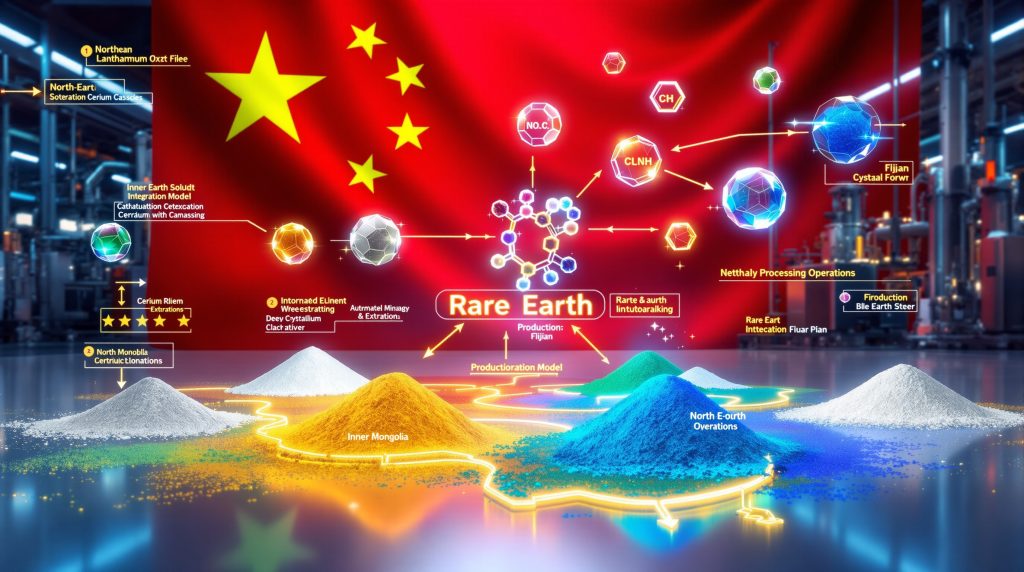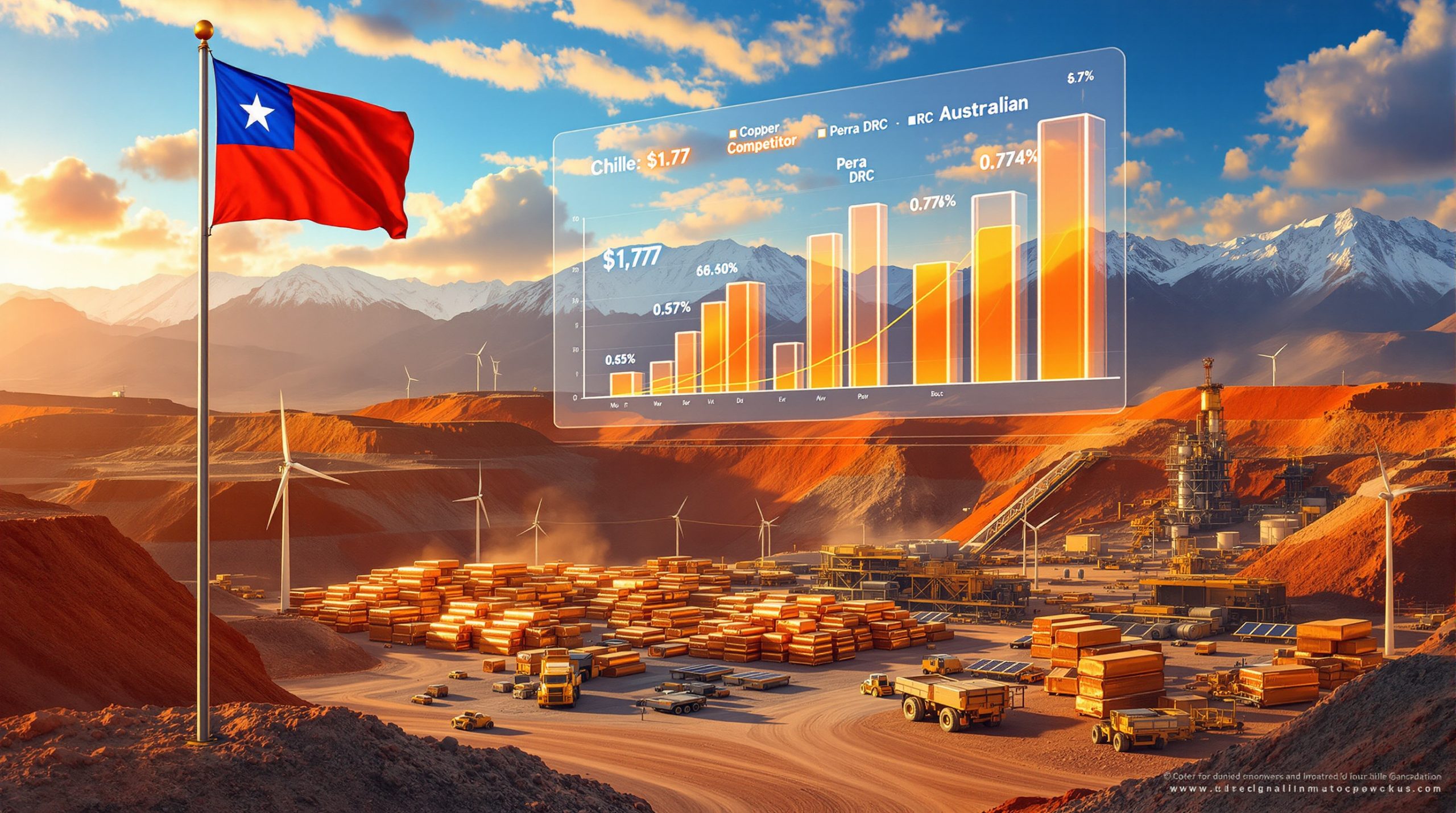Understanding China's Strategic Rare Earth Integration
The north south rare-earth separation project marks a transformative development in China's critical minerals supply chain strategy, showcasing how regional expertise combines through calculated partnerships between northern mining operations and southern processing facilities. This integration approach demonstrates Beijing's commitment to maintaining global dominance in rare earth element processing while optimising operational efficiency without expanding total production capacity.
China's approach centres on leveraging distinct regional advantages to create synergistic partnerships that strengthen the entire rare earth supply chain. Inner Mongolia provides abundant mineral resources and established mining infrastructure, while Fujian Province contributes advanced separation technologies and export capabilities. This complementary model has become a blueprint for maintaining market control whilst adhering to strict capacity constraints.
The Mechanics of Capacity Equal-Replacement Policy
China's capacity equal-replacement framework ensures that any new rare earth separation facilities must replace existing capacity elsewhere in the national system. This policy mechanism allows for technological modernisation and geographic optimisation without increasing overall output levels, maintaining Beijing's strategic control over global rare earth supply.
The policy operates through several key mechanisms that balance modernisation with market stability. Zero net capacity growth requirements mean new projects must offset equivalent existing facilities, whilst technology upgrades focus on replacing older processing lines with advanced systems. Regional optimisation enables production shifts to more efficient locations, and quality enhancement prioritises improved product specifications over volume increases.
Key Policy Components:
• Capacity Replacement: No net increase in national output maintains market control
• Technology Upgrades: Enhanced processing efficiency improves product quality
• Regional Integration: Optimised supply chain flows reduce operational costs
• Quality Focus: Emphasis on specifications rather than volume expansion
According to industry reports, this framework has enabled China to maintain approximately 90% of global rare earth processing capacity whilst continuously upgrading technological capabilities. The policy prevents overproduction that could destabilise prices while ensuring Chinese processors remain technologically competitive.
Northern Jinlong Project Specifications and Investment
The Northern Jinlong rare earth separation facility represents a ¥470 million investment (approximately $64 million USD) designed to process 5,000 tonnes of rare earth oxides annually. The Inner Mongolia Department of Industry and Information Technology approved this comprehensive project, which includes workshops, main processing plants, and administrative facilities.
Project Technical Details:
• Annual Capacity: 5,000 tonnes REO/year
• Investment Value: ¥470 million (~$64 million USD)
• Timeline: Construction completion by end-2026
• Product Range: 15 different oxide types
• Technology Focus: Advanced process control systems
The facility will produce an extensive portfolio of rare earth oxides essential for modern technology applications. Light rare earth elements include lanthanum oxide for catalyst applications, cerium oxide for polishing compounds, praseodymium-neodymium oxide for permanent magnets, and neodymium oxide for high-strength magnetic applications.
Heavy rare earth element production encompasses dysprosium oxide for wind turbine magnets, terbium oxide for phosphor applications, yttrium oxide for LED phosphors, and europium oxide for display technologies. Additional elements include samarium, gadolinium, holmium, erbium, thulium, ytterbium, and lutetium oxides, providing comprehensive coverage of the rare earth spectrum.
| Element Category | Primary Applications | Strategic Importance |
|---|---|---|
| Light REEs (La, Ce, Pr, Nd) | Magnets, catalysts, polishing | High volume demand |
| Heavy REEs (Dy, Tb, Y, Eu) | Advanced magnets, phosphors | Critical performance applications |
| Specialty Elements (Ho, Er, Tm, Yb, Lu) | Niche technologies, research | Emerging applications |
Regional Partnership Dynamics and Strategic Benefits
The north south rare-earth separation project exemplifies China's strategic approach to regional complementarity, combining Inner Mongolia's upstream advantages with Fujian Province's processing expertise. This partnership model creates synergistic benefits that enhance overall supply chain resilience and operational efficiency.
Northern regions, particularly Inner Mongolia, offer abundant rare earth mineral deposits, established mining infrastructure, lower operational costs, and proximity to primary resource extraction sites. These advantages provide a solid foundation for upstream operations and raw material supply consistency.
Southern regions like Fujian Province contribute advanced separation technologies, skilled technical workforces, established market connections, and superior export infrastructure access. This combination enables sophisticated processing capabilities and efficient market distribution channels, reflecting broader trends in mining industry innovation.
Strategic Integration Benefits:
- Resource Optimisation: Efficient allocation of raw materials to processing facilities
- Technology Transfer: Sharing of advanced separation techniques across regions
- Market Responsiveness: Faster adaptation to changing demand patterns
- Cost Efficiency: Reduced transportation and coordination expenses
Furthermore, this integration model aligns with principles of modern mine planning that emphasise coordinated supply chain management. "Supply chain resilience emerges from cross-regional partnerships that reduce single-point failures and create redundant processing capabilities, enhancing overall system reliability and market responsiveness," according to industry analysis.
Industry analysis suggests this integration model provides significant competitive advantages over fragmented supply chains. Coordinated planning between upstream and midstream operations enables better inventory management, quality control, and customer service delivery. Additionally, the partnership facilitates faster certification cycles for new products and more reliable quality specifications.
Global Market Impact and Competitive Implications
The north south rare-earth separation project strengthens China's position in global rare earth markets by improving processing efficiency and product quality without increasing overall supply volumes. This creates substantial implications for international competitors and downstream manufacturers seeking supply chain diversification, particularly as part of broader energy transition strategy initiatives.
Market Impact Analysis:
| Factor | Impact on China | Impact on Competitors |
|---|---|---|
| Processing Efficiency | Enhanced profit margins | Increased cost pressure |
| Product Quality | Improved specifications | Higher standards required |
| Supply Reliability | Reduced processing bottlenecks | Greater supply chain risk |
| Market Control | Strengthened competitive position | Limited diversification options |
The enhanced efficiency of China's integrated model creates several challenges for countries attempting to develop alternative rare earth supply chains. Cost competitiveness remains difficult to achieve outside China due to scale economics and established infrastructure. Technical expertise in separation technologies remains concentrated in Chinese facilities, whilst smaller production volumes outside China increase per-unit costs significantly.
Investment requirements for competitive facilities present substantial barriers to entry. Establishing processing capabilities requires not only significant capital investment but also years of operational experience to achieve consistent quality and efficiency levels. This reality complicates Western diversification efforts and maintains China's strategic advantage in rare earth processing.
Western governments and companies face margin pressure as Chinese facilities improve cost structures and product quality through integration. For instance, better process yields and coordinated sales strategies could further pressure non-Chinese processors on cost competitiveness, quality consistency, and delivery reliability.
Advanced Separation Technologies and Process Innovation
Modern rare earth separation relies on sophisticated technologies that enable precise isolation of individual elements from complex mineral concentrates. The Northern Jinlong project incorporates several cutting-edge processing approaches that represent the current state of separation technology, including innovations discussed in reports from Northern Rare Earth and Xiamen Tungsten's separation project developments.
Primary Separation Technologies:
• Solvent Extraction Systems: Multi-stage extraction cascades using selective organic solvents with automated process control and high purity output capabilities
• Ion Exchange Processes: Selective resin technologies with continuous operation systems, reduced chemical consumption, and enhanced recovery rates
• Crystallisation Techniques: Controlled precipitation methods enabling high-purity crystal formation with automated harvesting and quality control integration
Advanced separation facilities incorporate sophisticated monitoring and control systems that optimise efficiency and product quality through real-time composition analysis, automated flow rate adjustments, comprehensive quality assurance protocols, and integrated environmental monitoring systems.
Process control automation has become increasingly critical for maintaining consistent product specifications and operational efficiency. However, modern facilities utilise artificial intelligence for process optimisation, predictive maintenance systems to reduce downtime, and advanced analytics for quality control and yield maximisation.
The integration of these technologies enables Chinese facilities to achieve higher purity levels, better recovery rates, and more consistent product quality compared to older separation facilities. Consequently, this technological advantage contributes significantly to China's competitive position in global rare earth markets.
Critical Mineral Security and Supply Chain Control
The north south rare-earth separation project highlights fundamental aspects of critical mineral security, particularly the importance of processing capabilities in maintaining supply chain control. Whilst numerous countries possess rare earth deposits, few have developed the sophisticated separation technologies necessary to produce market-ready materials.
Critical Security Factors:
- Processing Capacity: Ability to convert raw materials into usable products
- Technical Expertise: Skilled workforce capable of operating complex facilities
- Quality Standards: Meeting specifications for high-technology applications
- Scale Economics: Achieving competitive production costs through volume
Countries seeking to reduce dependence on Chinese rare earth processing face significant challenges in developing domestic capabilities. Processing facility construction requires substantial capital investment, typically ranging from $50 million to $200 million for commercial-scale operations. Furthermore, technical expertise development takes years of experience, whilst quality certification processes for critical applications can extend timeline requirements substantially.
Diversification Strategies:
• Domestic Processing Development: Building separation facilities in resource-rich countries
• Strategic Partnerships: Collaborating with allied nations on processing capabilities
• Technology Investment: Supporting research into alternative separation methods
• Stockpiling Programmes: Maintaining strategic reserves of processed materials
The capacity equal-replacement policy demonstrates China's sophisticated approach to maintaining market control whilst avoiding oversupply conditions. This policy framework provides Beijing with flexibility to optimise processing capabilities geographically and technologically without triggering market instability through excess capacity.
Environmental Considerations and Sustainable Processing
Modern rare earth separation facilities must balance production efficiency with environmental responsibility, incorporating advanced waste management and emission control systems. The Northern Jinlong project includes comprehensive environmental protection measures that reflect evolving regulatory requirements and sustainability expectations, aligning with mining decarbonisation benefits principles.
Environmental Management Systems:
• Waste Minimisation: Reducing chemical consumption and byproduct generation through process optimisation
• Water Treatment: Advanced filtration and recycling systems to minimise freshwater consumption
• Emission Controls: Air quality monitoring and treatment systems for particulate and chemical emissions
• Regulatory Compliance: Meeting increasingly strict environmental standards and reporting requirements
Circular economy integration has become increasingly important in rare earth processing operations. Advanced separation facilities focus on resource recovery and recycling through byproduct utilisation, converting waste streams into useful materials, recycling integration for processing end-of-life products containing rare earths, energy efficiency measures to minimise power consumption, and sustainable chemistry using environmentally friendly extraction agents.
Environmental compliance costs represent a significant operational expense for rare earth processing facilities. Estimates suggest environmental protection systems can account for 15-20% of total facility investment costs, whilst ongoing compliance expenses may represent 8-12% of annual operating costs. These factors favour larger, more technologically advanced facilities that can achieve economies of scale in environmental management.
Future Technology Trends and Market Evolution
The rare earth processing industry continues evolving with emerging technologies and approaches that promise improved efficiency and reduced environmental impact. Several development areas show particular promise for advancing separation capabilities and operational performance.
Technology Development Areas:
• Artificial Intelligence: AI-driven process optimisation for improved yield and quality control
• Green Chemistry: Development of environmentally friendly separation agents and processes
• Modular Systems: Scalable processing units that reduce capital requirements and implementation timelines
• Advanced Automation: Further reduction of labour requirements and improvement of process consistency
Market evolution reflects growing demand for rare earth elements in clean energy and advanced technology applications. Electric vehicle expansion drives increasing demand for permanent magnet materials, whilst renewable energy deployment requires rare earths for wind turbine generators and solar panel components. In addition, electronics growth continues expanding consumer device applications, and defence requirements include advanced military technologies requiring specialised rare earth materials.
What are the key growth drivers for rare earth demand?
Key Growth Drivers:
- Electric Vehicle Market: Projected to require 200,000+ tonnes of rare earth magnets annually by 2030
- Wind Energy Expansion: Each megawatt of wind capacity requires approximately 200kg of rare earth materials
- Electronics Proliferation: Consumer devices, data centres, and communications infrastructure
- Defence Applications: Precision-guided munitions, radar systems, and electronic warfare capabilities
Industry projections suggest rare earth demand could increase by 300-400% over the next decade, driven primarily by clean energy and electrification trends. This demand growth supports continued investment in processing capabilities and technological advancement, reinforcing the strategic importance of projects like the north south rare-earth separation project.
The integration model demonstrated by the Northern Jinlong project may become a template for other countries seeking to develop competitive rare earth processing capabilities, as highlighted in recent analysis of Australia's Northern Territory rare earth investment opportunities. However, replicating China's success requires substantial investment, technical expertise development, and long-term commitment to building integrated supply chain capabilities.
Disclaimer: This analysis is based on publicly available information and industry reports. Rare earth market conditions and technological developments may change rapidly, affecting the relevance of specific data points and projections. Readers should verify current information before making investment or strategic decisions.
Exploring Opportunities in Rare Earth and Critical Minerals Investing?
Discovery Alert's proprietary Discovery IQ model delivers real-time alerts on significant critical minerals discoveries across the ASX, instantly empowering subscribers to identify actionable opportunities ahead of the broader market. Understand why major mineral discoveries can lead to substantial returns by exploring Discovery Alert's dedicated discoveries page, showcasing historic examples of exceptional outcomes, and begin your 30-day free trial today to position yourself ahead of the market.




